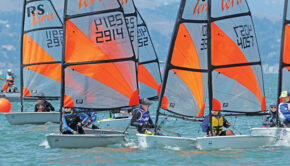Taking Flight: Is Foiling now Mainstream?
Published on December 17th, 2013
By Kimball Livingston, Sail Magazine
Remember learning that the basic motions of a boat are roll, pitch and yaw? Now add “heave,” the nautical engineering term for the lift of a hydrofoil, or “foil,” as we seem destined to call them.
Foiling has been around for years, but the 2013 America’s Cup on San Francisco Bay turned up the spotlight dramatically on a phenomenon that has become exponentially more widespread of late – albeit beneath the radar of many sailors. In 2012, Oracle Team USA skipper Jimmy Spithill famously declared, “Foils are the future,” as we watched 72-foot catamarans begin flying at near-freeway speeds, and only two weeks after the Defender’s epic Cup comeback, an inaugural American foilboard event for kite sailors was launched on the same patch of water. At the same time, some 2,300 miles to the west, the Moth World Championship was underway on Kaneohe Bay, Hawaii, with 80 of the world’s best sailors competing in an 85-year-old dinghy class where the first world championship race win for a foiler only dates to 2001.
Bottom line: foiling may not be for you, but the awkward courtship is over. Foiling is the glamorous new in-law in our sailing family, so grab the smelling salts for Granny, and make room at the table.
What a poverty of language we’re exposing here, compared to Eskimo dialects and their umpteen different words for snow. A sail is a foil. So is a wing, a rudder or a keel. But it seems we’re stuck with the word. The essential feature of this foil is that it runs deep in the water, develops heave and lifts the hull(s) clear. There are immediate consequences for design, because hulls then become little more than foil delivery systems. The Moth being a development class, for example, designers are motivated to produce hulls that are fast up to takeoff speed. But above 7 knots, the hull is merely a place to sit, with windage minimized as much as possible. Foiling Moths double the speed of nonfoiling Moths – there’s a 30 Knot Club – and helmets are popular. You’re going fast enough to hurt yourself. We recall that, for the 11 men on an AC72, a helmet was only the beginning of the body armor. It’s a brave new world.
With the America’s Cup still underway, enthusiasts were also following the 2013 International C-Class Catamaran Championship in Falmouth, England. C-Cats have long been an exotic otherness as a development playground for hard wings and lifting foils. But with a record 11 entries in 2013, the leading boats struck the eye as miniature versions of AC72s: a role reversal for a group whose pioneers – Duncan MacLane and David Hubbard, for example – received offers as soon as the tipping point arrived for designing the giant catamaran and equally giant tri that took part in the 2010 Deed of Gift match. The circle is complete. – Read on









 We’ll keep your information safe.
We’ll keep your information safe.